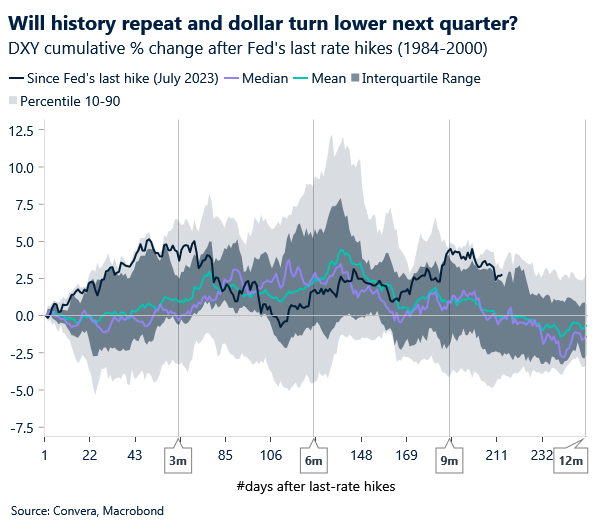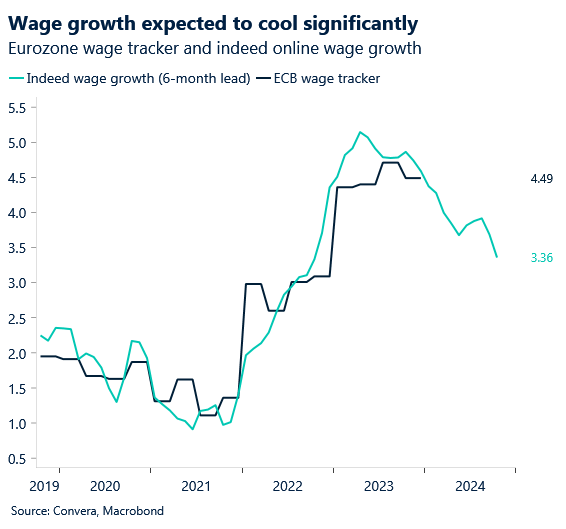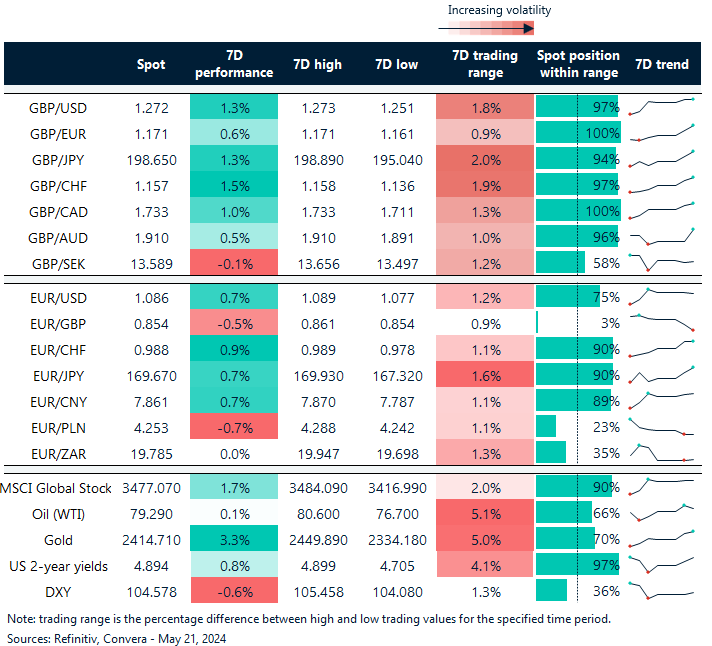Written by Convera’s Market Insights team
Dollar steadies as Fed guidance in focus
George Vessey – Lead FX Strategist
The US dollar index is extending gains from the previous session following one of its worst weeks of the year so far. Last week, the dollar lost ground to pro-cyclical peers – those currencies that perform better on hopes of improving global economic growth. The reason why these hopes have increased is because of rising expectations of interest rate cuts to support economies.
Nevertheless, the global risk rally has fizzled out somewhat as Atlanta Fed President Raphael Bostic said that it will take time before the central bank is confident that inflation will return to 2%, reiterating that only one rate cut will be necessary this year. In the short-term, we think a low volatility environment should offer the dollar some more reprieve given its high yield appeal in the carry trade strategy. But as we move into the second half of the year, it seems more plausible for the dollar to weaken amid the moderating US growth outlook and if the disinflation trend resumes. Looking back at what has historically happened to the dollar after the Fed’s last rate hike, we see the US currency is currently in the 90th percentile of its historical performances. However, if history repeats, we should see the dollar’s strength subside.
With little on the US economic data calendar this week to guide the direction of currency moves in the very near term, focus remains on a slew of Fed speakers for clues on the US rate outlook and how soon an easing cycle could begin.

Climbing ahead of inflation data
George Vessey – Lead FX Strategist
Sterling remains afloat the $1.27 handle versus the US dollar, just 1.4% away from its 2024 high near $1.29. The 100-day moving average appears to have flipped from a short-term resistance level to an area of support, though this could be tested following tomorrow’s UK inflation report. GBP/EUR has also climbed back above €1.17 to a fresh 2-week high.
Unlike the US, UK inflation in recent quarters has undershot the central bank’s expectations and is likely to return to target in the next month or two. The headline CPI print on Wednesday is forecast to fall from 3.2% to 2.1%, which could raise the prospect of a Bank of England (BoE) interest rate cut as soon as June. However, the BoE is more focused on services inflation – giving it more prominence in the monetary policy decision-making process given recent volatility in the wage figures. If it comes in hotter than anticipated odds of a June cut will likely be slashed, helping the pound stretch towards $1.28.
On the flip side, a sharp deceleration in services inflation will raise the probability of a June start and potentially even a consecutive August cut. Such a scenario could heavily weigh on the pound and drag GBP/USD back under its key moving averages and into the lower $1.20s.

Euro faces mild downside pressure
Ruta Prieskienyte – FX Strategist
The euro retreated against the US dollar amid a quiet start to the week and a thin data calendar. EUR/USD traded in a tight 30 pip range just off the daily open of $1.0867 with daily realised volatility retreating to 3.6% on annualised basis, substantially below the 1-month level of 5.6%. Both European bonds and stocks remained steady, awaiting new catalysts on the monetary policy outlook.
With today’s calendar sprinkled with a few domestic data releases, we should expect realised volatility to pick up during the course of the trading day, admittedly from subdued levels. Eurozone labour cost index report is due shortly, one of the key metrics weighed by the ECB when deciding how much to ease monetary policy following an initial reduction in rates. Markets are expecting 2.9% q/q growth, down from 3.4% q/q observed in Q4 2023. A confirmation or downward surprise to the consensus will not change near term ECB rate cut expectations, given that the June cut is already fully priced in, but could see further easing priced in for the end of the year. The latest swap implied expectation stands at 67bps of cumulative easing by the end of 2024. Meanwhile, signs of a stickier than expected wage growth could prompt the ECB to act more cautiously after the initial rate cut given its data dependent policy stance. Consequentially investors could pullback on at part of easing expectations, bringing it more in line with the Fed, which currently stands at 51bps by end of 2024.
From a technical standpoint, as EUR/USD trades above its 200-day SMA and is currently testing the upper Bollinger band, the pair should pull back from the current stretched levels as momentum meets fading interest. Short term options market sentiment, as measured by 1-week EUR/USD risk reversals, continues to favour euro calls, but the rally to $1.09 appears overdone given lingering concerns surrounding the US disinflation trend.

Gold up over 3% in a week
Table: 7-day currency trends and trading ranges

Key global risk events
Calendar: May 20-24

Have a question? [email protected]
*The FX rates published are provided by Convera’s Market Insights team for research purposes only. The rates have a unique source and may not align to any live exchange rates quoted on other sites. They are not an indication of actual buy/sell rates, or a financial offer.



